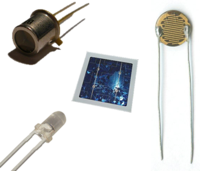
Photo from wikipedia
The tactile perception of an object’s surface material plays an important role in many intelligent fields including object recognition, robotic grasp, and environment exploration. Enlightened by the human active tactile… Click to show full abstract
The tactile perception of an object’s surface material plays an important role in many intelligent fields including object recognition, robotic grasp, and environment exploration. Enlightened by the human active tactile perception process that originates from scanning a finger on the surface, a novel finger-like tactile sensor for surface material recognition has been designed according to the transduction mechanism of cilia and Villari effect of the iron–gallium alloy. Based on the structural dynamic theory of Euler–Bernoulli beam, the linear constitutive equations of magetostrictive material and the Faraday law of electromagnetic induction, the output voltage model of the sensor under vibration induced from the fingertip-surface scanning has been established. Furthermore, a prototype of the sensor, on the macroscale, is fabricated. In order to verify the performance, the sensor is used to measure induced vibration signals with texture properties during sliding on the surface and classify five similar texture surfaces with small differences with a classification algorithm. The experimental results indicate that the proposed tactile sensor is effective and highly accurate for surface material classification. The sensor is characterized by high sensitivity and quick response. It has the potential of being miniaturized and integrated into the finger of a robotic hand to realize surface material recognition in real time.
Journal Title: IEEE Transactions on Magnetics
Year Published: 2019
Link to full text (if available)
Share on Social Media: Sign Up to like & get
recommendations!